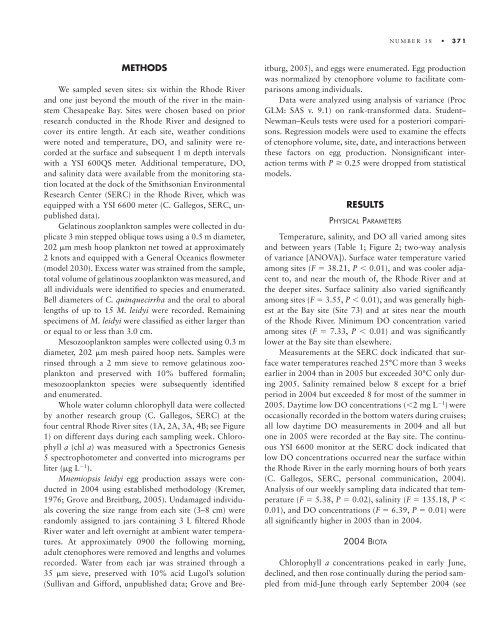Interannual Variation in Gelatinous Zooplankton and Their Prey in ...
Interannual Variation in Gelatinous Zooplankton and Their Prey in ...
Interannual Variation in Gelatinous Zooplankton and Their Prey in ...
You also want an ePaper? Increase the reach of your titles
YUMPU automatically turns print PDFs into web optimized ePapers that Google loves.
METHODS<br />
We sampled seven sites: six with<strong>in</strong> the Rhode River<br />
<strong>and</strong> one just beyond the mouth of the river <strong>in</strong> the ma<strong>in</strong>stem<br />
Chesapeake Bay. Sites were chosen based on prior<br />
research conducted <strong>in</strong> the Rhode River <strong>and</strong> designed to<br />
cover its entire length. At each site, weather conditions<br />
were noted <strong>and</strong> temperature, DO, <strong>and</strong> sal<strong>in</strong>ity were recorded<br />
at the surface <strong>and</strong> subsequent 1 m depth <strong>in</strong>tervals<br />
with a YSI 600QS meter. Additional temperature, DO,<br />
<strong>and</strong> sal<strong>in</strong>ity data were available from the monitor<strong>in</strong>g station<br />
located at the dock of the Smithsonian Environmental<br />
Research Center (SERC) <strong>in</strong> the Rhode River, which was<br />
equipped with a YSI 6600 meter (C. Gallegos, SERC, unpublished<br />
data).<br />
Gelat<strong>in</strong>ous zooplankton samples were collected <strong>in</strong> duplicate<br />
3 m<strong>in</strong> stepped oblique tows us<strong>in</strong>g a 0.5 m diameter,<br />
202 m mesh hoop plankton net towed at approximately<br />
2 knots <strong>and</strong> equipped with a General Oceanics fl owmeter<br />
(model 2030). Excess water was stra<strong>in</strong>ed from the sample,<br />
total volume of gelat<strong>in</strong>ous zooplankton was measured, <strong>and</strong><br />
all <strong>in</strong>dividuals were identifi ed to species <strong>and</strong> enumerated.<br />
Bell diameters of C. qu<strong>in</strong>quecirrha <strong>and</strong> the oral to aboral<br />
lengths of up to 15 M. leidyi were recorded. Rema<strong>in</strong><strong>in</strong>g<br />
specimens of M. leidyi were classifi ed as either larger than<br />
or equal to or less than 3.0 cm.<br />
Mesozooplankton samples were collected us<strong>in</strong>g 0.3 m<br />
diameter, 202 m mesh paired hoop nets. Samples were<br />
r<strong>in</strong>sed through a 2 mm sieve to remove gelat<strong>in</strong>ous zooplankton<br />
<strong>and</strong> preserved with 10% buffered formal<strong>in</strong>;<br />
meso zooplankton species were subsequently identifi ed<br />
<strong>and</strong> enumerated.<br />
Whole water column chlorophyll data were collected<br />
by another research group (C. Gallegos, SERC) at the<br />
four central Rhode River sites (1A, 2A, 3A, 4B; see Figure<br />
1) on different days dur<strong>in</strong>g each sampl<strong>in</strong>g week. Chlorophyll<br />
a (chl a) was measured with a Spectronics Genesis<br />
5 spectrophotometer <strong>and</strong> converted <strong>in</strong>to micrograms per<br />
liter (g L 1 ).<br />
Mnemiopsis leidyi egg production assays were conducted<br />
<strong>in</strong> 2004 us<strong>in</strong>g established methodology (Kremer,<br />
1976; Grove <strong>and</strong> Breitburg, 2005). Undamaged <strong>in</strong>dividuals<br />
cover<strong>in</strong>g the size range from each site (3– 8 cm) were<br />
r<strong>and</strong>omly assigned to jars conta<strong>in</strong><strong>in</strong>g 3 L fi ltered Rhode<br />
River water <strong>and</strong> left overnight at ambient water temperatures.<br />
At approximately 0900 the follow<strong>in</strong>g morn<strong>in</strong>g,<br />
adult ctenophores were removed <strong>and</strong> lengths <strong>and</strong> volumes<br />
recorded. Water from each jar was stra<strong>in</strong>ed through a<br />
35 m sieve, preserved with 10% acid Lugol’s solution<br />
(Sullivan <strong>and</strong> Gifford, unpublished data; Grove <strong>and</strong> Bre-<br />
NUMBER 38 • 371<br />
itburg, 2005), <strong>and</strong> eggs were enumerated. Egg production<br />
was normalized by ctenophore volume to facilitate comparisons<br />
among <strong>in</strong>dividuals.<br />
Data were analyzed us<strong>in</strong>g analysis of variance (Proc<br />
GLM: SAS v. 9.1) on rank-transformed data. Student–<br />
Newman– Keuls tests were used for a posteriori comparisons.<br />
Regression models were used to exam<strong>in</strong>e the effects<br />
of ctenophore volume, site, date, <strong>and</strong> <strong>in</strong>teractions between<br />
these factors on egg production. Nonsignifi cant <strong>in</strong>teraction<br />
terms with P 0.25 were dropped from statistical<br />
models.<br />
RESULTS<br />
PHYSICAL PARAMETERS<br />
Temperature, sal<strong>in</strong>ity, <strong>and</strong> DO all varied among sites<br />
<strong>and</strong> between years (Table 1; Figure 2; two-way analysis<br />
of variance [ANOVA]). Surface water temperature varied<br />
among sites (F 38.21, P 0.01), <strong>and</strong> was cooler adjacent<br />
to, <strong>and</strong> near the mouth of, the Rhode River <strong>and</strong> at<br />
the deeper sites. Surface sal<strong>in</strong>ity also varied signifi cantly<br />
among sites (F 3.55, P 0.01), <strong>and</strong> was generally highest<br />
at the Bay site (Site 73) <strong>and</strong> at sites near the mouth<br />
of the Rhode River. M<strong>in</strong>imum DO concentration varied<br />
among sites (F 7.33, P 0.01) <strong>and</strong> was signifi cantly<br />
lower at the Bay site than elsewhere.<br />
Measurements at the SERC dock <strong>in</strong>dicated that surface<br />
water temperatures reached 25°C more than 3 weeks<br />
earlier <strong>in</strong> 2004 than <strong>in</strong> 2005 but exceeded 30°C only dur<strong>in</strong>g<br />
2005. Sal<strong>in</strong>ity rema<strong>in</strong>ed below 8 except for a brief<br />
period <strong>in</strong> 2004 but exceeded 8 for most of the summer <strong>in</strong><br />
2005. Daytime low DO concentrations (2 mg L 1 ) were<br />
occasionally recorded <strong>in</strong> the bottom waters dur<strong>in</strong>g cruises;<br />
all low daytime DO measurements <strong>in</strong> 2004 <strong>and</strong> all but<br />
one <strong>in</strong> 2005 were recorded at the Bay site. The cont<strong>in</strong>uous<br />
YSI 6600 monitor at the SERC dock <strong>in</strong>dicated that<br />
low DO concentrations occurred near the surface with<strong>in</strong><br />
the Rhode River <strong>in</strong> the early morn<strong>in</strong>g hours of both years<br />
(C. Gallegos, SERC, personal communication, 2004).<br />
Analysis of our weekly sampl<strong>in</strong>g data <strong>in</strong>dicated that temperature<br />
(F 5.38, P 0.02), sal<strong>in</strong>ity (F 135.18, P <br />
0.01), <strong>and</strong> DO concentrations (F 6.39, P 0.01) were<br />
all signifi cantly higher <strong>in</strong> 2005 than <strong>in</strong> 2004.<br />
2004 BIOTA<br />
Chlorophyll a concentrations peaked <strong>in</strong> early June,<br />
decl<strong>in</strong>ed, <strong>and</strong> then rose cont<strong>in</strong>ually dur<strong>in</strong>g the period sampled<br />
from mid-June through early September 2004 (see
















